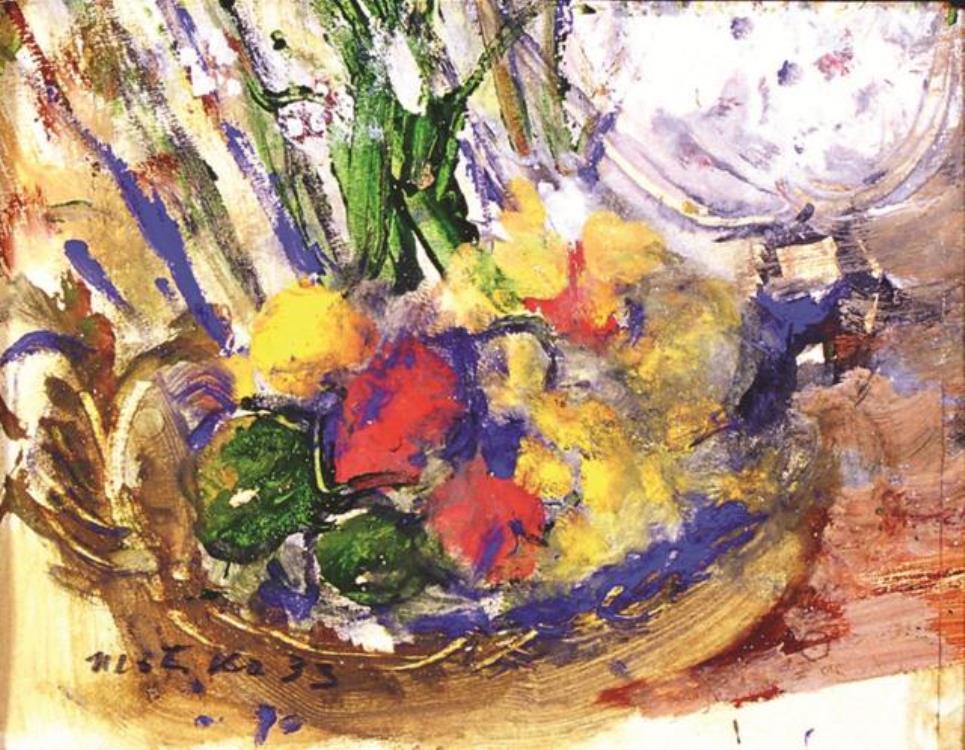
Antun Motika was an artist open to new media, attached to no particular programme or tendency, without any prejudice or expectation: he was a creator who was allowed to tread outside the boundaries of an “individual style”. He was an artist who explored certain visual problems, verified his results, elaborated them through relentless dialectics and finally synthesized them in one of his following creative phases. Through all his cycles, transformations and inventions, Motika is characterized by a distinct creative autonomy, by an understanding of modern art movements based on a historic perspective and logical analysis, and by a holistic concept of painting. In Motika's works we find nothing that should he read into their backgrounds: everything is visible and entirely entrusted to the painting. Despite his wide diversity of techniques and motifs, Motika never forsook his artistic ethics. On the contrary, precisely due to his open attitude toward different media and concepts, his works, created over a period of almost one hundred years, represent a special quality in Croatian art history. This is why placing Antun Motika in a historic context is especially difficult. In the Croatian painting of the tirst half of the 20th century, he was a pioneer of the modernist expression, which he introduced through his development from Realism (or even Romanticism) to Impressionism, Post-Impressionism and eventually abstract art. This path was legitimate so to speak, because from the very beginning Motika combined impression and expression in his paintings, creating an impression-expression model that was at the same time open to more radical formulations. The main issue of his artistic procedure consisted in the fact, that in spite of his adherence to classic topics, Motika was constantly at the edge of abstract art,of its exclusive inner illusionism. His aspiration to a holistic depiction (whether he painted landscapes, objects or persons) did not result from stringing together details but from an effort to visualize highly developed cognitive concepts, holistic entities, using the formulation of the painting and his expressive gesture carefully integrated in the developing structure of its surface. Motika was possibly indeed the “most abstract” painter of his generation. He took a strong interest in the theory of painting and was at the same time extremely impulsive when it came to his own work, which might be the reason why he was partly isolated from a response in the Croatian art critique and art history. Most domestic critics and art historians regarded him as a painter of a distinctive personal instinct and temperament, who employed operational strategies developed from his Parisian experiences to tackle certain formal contextual issues. The existing form elements and their variations - such as the lightening of his palette through the use of primary, pure colours and transparent surfaces of white, or the detachment of the line from its describing role as contour and its transformation into a dynamically coloured arabesque - which were undoubtedly very important for Motika's overall development as an artist - obviously did not suffice for the critics to define a deviation from mainstream Croatian art of the time, even if some of them noticed, but failed to unequivocally formulate it. Art critics found Motika”s points of departure in the artistic diversity ofthe “Parisian School”, in stylistic evolutions of the French tradition and in influences of Bonnard, Dufy or Matisse, which was indeed true, but entirely irrelevant when it came to the complex issues of his work and thus to the value discourses in the domestic art scene. Today, from a historic perspective, it may be stated that Motika's essentially modern body of work contains certain segments of typological and ideological models differing from the dominant movements of his time. Motika's concept of art as a process, an experiment and a rethinking of its very nature, as opposed to an a priori acceptance of the work of art as an aesthetic object, places him among those artists that can be described as the historic avant-garde of the inter-war period. After World War II and the end of Social Realism, Motika's art was correctly categorized as a special phenomenon of the neoavant-garde in Croatia. lt is however less commonly known, that in the inter-war period Motika achieved nearly equal potentials of avant-garde meaning through traditional operational painting procedures. These works were exhibited in the past, known but not fully recognized in their twofold role, namely as deviations and transgressions from mainstream art processes, and as continuous processes of the artist's personal existence. Motika searched consciously for new approaches to the articulation of the realm of painting by working in “less valuable” media, which he would then exhibit as his latest and representative production. This pertains above all to his gouaches, pastels, temperas, watercolours, collages and, of course, to his drawings, which have long been coined to be “the read book of his destiny”. In the second half of the 20th century, Motika also created glass sculptures, which only represent a continuation of his painterly concepts of light transformation in a different medium. Let us also mention his insufficiently explored lumino-kinetic film projections and his today revalued photomontages and other surrealist procedures. Motika's place in the process of redefining art disciplines is thus as equally valuable as his peculiar artistic language. In the existing art system of an integrated majority, there was no space for different, individual artistic positions. Therefore Motika's position in this system was accepted only inasmuch, as it did not deviate from the general (artistic) practice of his time. But for Antun Motika the choice of materials he worked in was rather irrelevant, because in his artistically accomplished, brilliant and clear manner he used them time and again to express his firm belief that the role and the meaning of art lies neither in the uncompromising quest of the new nor in the blind imitation of the past, but in the artist's aspiration to transform the visible and bring it closer to the ideal of the timeless high culture ofpainting. Like many other great artists, Motika too was not above identifying the sources and motifs he adopted from the visual tradition, which did not derive from an inability to find his own expression, but from a logical awareness of his participation in the Western European art experience. Throughout his life, Motika was a gentleman of painting, always a companion of the events. In line with the high and constant quality of his work, independent of the course of history, of turbulent art movements, style changes and tendencies, Motika was an artist who lived his time sincerely, actively and curiously, not being able to separate life and work. lt is in these circumstances that he developed a specific artistic language, which inarguably enriched the expressive potential of modernist painting not only in Croatian but also in European proportions. For the presentation of the long-awaited Antun Motika Donation, which in his lifetime the artist himself wished to establish in his home town, a selection of works illustrative of his development and his conceptual issues was made. Even though the exhibited pieces are not numerous - owing also to the limited exhibition space - they suffice to demonstrate that in Motika's approach to visual art no petrified and frozen situations existed, only changes, transformations and oscillations, in a way making him an analyst of the artistic processes that were taking place in the environments in which he lived and worked. He thus escapes the usual division into phases, periods or thematic areas, as with Motika it is absolutely legitimate to find one and the same motif or treatment thereof in a work from 1935 and in one from 1960. Let us take the “Desk” and the “Schoolgirl” as an example. Were these paintings not signed, one could easily date the “Schoolgirl into the thirties, instead of the period of Art lnformel and the beginning of the New Tendencies, when in fact it was created. Or let us take the “Potted Plants” from 1932, which some ten years later were transformed into a geometrie collage. The “Interior” from 1955 is almost a copy of the formal relations existing in the “Potted Plants”, but instead of the principle of geometrie flatness, which Motika after the aforesaid collage employed in the “Harlequin” from 1952 and the “Black Harlequin” from 1956/ 57, the composition was transformed into a polyphony of coloured lines. We also find these in the small gouache “Fruit Basket” from 1933 and the painting “Inn the Kitchen” from 1936. Although We have named only a few examples of a possible interpretation model, they show that the evolution of Motika°s style Was not subject to any formalities, but was continuously on the threshold of transition, making it difficult, and in view of his gigantic oeuvre and the number of undated Works nearly impossible, to determine when and where something new or different appeared, When and where it. Was transformed or reproduced, When and where it became a manner or ended. Since the Antun Motika Donation cannot be presented in detail here - we believe that this will be possible through a future series of exhibitions presenting different thematic cycles - we yielded to a somewhat sentimental desire to return to the beginnings of Motika's artistic path. As the Donation has returned to the city where Antun Motika was born, where he went to school and grew up, this is an appropriate occasion to show his earliest works - portraits, cityscapes, illustrated books and notebooks, caricatures - a sort of liomage to Motika's Istrian period (Pula, Žminj, Orbanići, Pazin). The illustrated stories from the “Istrian Chaos of War- and Peacetime” do not necessarily have an artistic value. They are primarily valuable from the historic point of view, as documents but also as sources for the reconstruction of Motika's spiritual dimension. From these materials one can deduce not only his artistic capabilities but also his understanding of historic processes and his personal place in them. These early, or rather earliest Works show that even When Motika was still a schoolboy in Pula and Pazin his path of life Was predictable; they stand at the beginning of a “logical development” of the artist's entire life's work,occupying a unique and specific position in Croatian 20. century art.
More info
More info on the page in Croatian language
Artwork photo gallery
Links

